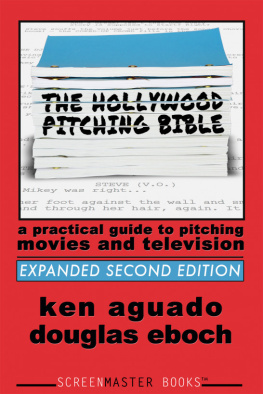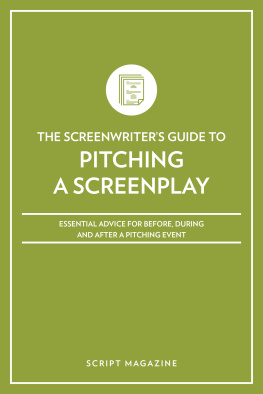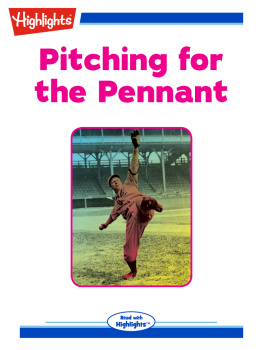The Hollywood Pitching Bible
A Practical Guide to Pitching Movies andTelevision
Expanded Second Edition
By
Ken Aguado & Douglas Eboch
Copyright 2014
SCREENMASTER BOOKS
Copyright 2013, 2014 by Douglas Eboch & KenAguado.
All rights reserved.
Published by ScreenMaster Books at Smashwords
No part of this publication may be reproduced, storedin a retrieval system, or transmitted in any form or by any means,electronic, mechanical, photocopying, recording, scanning, orotherwise, except as permitted under Section 107 or 108 of the 1976United States Copyright Act, without either the prior writtenpermission of the authors.
Limit of Liability/Disclaimer of Warranty: While theauthor have used their best efforts in preparing this book, theymake no representations or warranties with respect to the accuracyor completeness of the contents of this book and specificallydisclaim any implied warranties for a particular purpose. Nowarranty may be created or extended by sales representatives orwritten sales materials. The advice and strategies contained hereinmay not be suitable for your situation. The authors shall not beliable for any loss of profit or any other commercial damages,including but not limited to special, incidental, consequential, orother damages.
This book is available in print at most onlineretailers.
Cover photos by Scott Peat.
For more information or permissions, pleasecontact:
ScreenMaster Books
5737 Kanan Road, Suite 114
Agoura Hills, CA 91301
Praise for The Hollywood Pitching Bible
A lot of us muddle through, hoping like hell we knowwhat were doing when faced with selling our wares to the PowersThat Be. With this book, the power is now in your hands. No morehoping and floundering the dark with your story. Hit the lights.Stop hoping. Know.
-David Simkins (Writer of Adventures inBabysitting, Grimm, Warehouse 13)
Luck, they say, is when preparation meetsopportunity. Consider yourself lucky that Douglas Eboch &Ken Aguado have written a book that tells you not only how toachieve a screenwriting career, but also sustain it overtime.
-Lem Dobbs (Screenwriter of Dark City, TheLimey, The Score, Haywire)
Theres nothing else like this book out there - apractical, down to earth, common sense guide to the art and scienceof the pitch written by two guys who have years of experience inthe trenches. Its not only full of spot on advice and technique,it also covers what to expect in the room, pitching etiquette,pitching movies vs. television - all in all it will make you abetter storyteller.
-John Gray (Writer/Director of GhostWhisperer)
Nine companies passed on the Liar Liar pitchbefore we sold it four years later. If Id read this bookback then, we might have sold it four years earlier.
-Paul Guay (Writer, Liar Liar)
An essential book about an essential skill.
-Ross LaManna (Writer of Rush Hour)
Most writers find the pitching process to be quitenerve-wracking, and this long-overdue book will offer them greatcomfort and encouragement. Douglas Eboch and Ken Aguado breakdown every aspect of a pitch, from the development of an idea tothe challenge of confidently facing a room full of stone-facedexecutives. Moreover, they stress the importance of making areal personal connection to your material. If you have anurgent need to tell a particular story, there isnt a buyer in theworld who wont want to hear it.
-Ken Kwapis (Director of Hes Just Not ThatInto You, Big Miracle)
Ken Aguado and Doug Eboch are guys who walk thewalk, and here they talk the talk. They know as well asanyone how to navigate the trickiest waters on the continent:Hollywoods pitching process. Demystifying the secrets ofwhat works and what doesnt for the not-so-brave new world ofcorporate Movie Biz. Its on my top shelf of books I cant bewithout.
-John Badham (Director of Saturday NightFever, WarGames, Stakeout)
CONTENTS
.
Preface
Welcome to the second edition of The HollywoodPitching Bible. We are thrilled to be back. When we wrote the firstedition, we really didnt expect the overwhelmingly positivereception the book would get. We certainly knew that we werewriting about a subject matter that was both incredibly importantfor Hollywood career longevity but also suffered from an incredibledearth of good information. We also knew from our teachingexperiences how students struggled with pitching, and this gave usinsight into the most challenging aspects of the pitching process.Still, when a new book is set free upon the world you never knowwhat the reaction will be. The good news is that the book receiveduniformly positive reviews and the book is now required reading atseveral film schools around the country. Just as importantly, welistened to reader feedback, many of whom asked us to expand onsome of our more formidable ideas. So here we are for roundtwo.
But first, a little recap.
The first edition of The Hollywood Pitching Biblecame about when Ross LaManna (the Chair of the Undergraduate andGraduate Film Departments at the Art Center College of Design inPasadena, California) asked if we would help create a graduatelevel class in pitching. Ross, being an established Hollywoodscreenwriter, was deeply acquainted with the value of learning topitch. He knew that, while many film classes can teach you how towrite a script or operate a camera, understanding how to presentyour ideas (and present yourself) is where the rubber meets theroad in showbiz. He knew that sending a graduate into the workingworld without knowing how to sell themselves and their projects isleaving them half-armed. In retrospect, Ross idea was prettyclever: take a Hollywood screenwriter (Doug) and put him in anarranged marriage with an experienced producer (Ken) to create apitching curriculum that was able to explain pitching from bothsides of the desk. Prior to that, Doug and Ken had never met. Butit worked, and our first edition was the successful offspring ofour combined knowledge.
For the second edition of The Hollywood PitchingBible we are digging even deeper into pitching, with many morespecific examples of pitches (by request) and we also greatlyexpanded some of the core components and unique principles weoriginated in the first edition (also, by request). We expanded ourcoverage of reality programming and added more information aboutpitching from a director and producers perspective. Weve alsoadded many anecdotes from top Hollywood professionals about howthey actually pitched and sold their projects that got made. All ofthese contributors did a stellar job and their stories are reallyilluminating. It is our sincerest hope that this will help make TheHollywood Pitching Bible a definitive and practical resource foryears to come.
Lastly, wed like to acknowledge some of the peoplewho have helped us out with the second edition. Let us formallythank Ross LaManna for planting the seed for this book, and for hisongoing and relentless support for the program we created. Weshould also thank aspiring filmmaker Pavan Ojha for his help andsupport as we crafted the materials for this new edition.
We are also hugely grateful to the following group ofsupremely accomplished artists who lent us their names,credibility, and wisdom for this expanded second edition of TheHollywood Pitching Bible. They are: Robert Eisele, Tony Gayton,Gary Goldman, John Gray, Paul Guay, Grady Hall, Eric Heisserer,Jeremy Podeswa and Arlene Sanford. These artists contributedilluminating quotes about some of the topics we tackle in the book,and also stories about the pitches theyve sold. Weve includedtheir stories in this new edition. We think these stories add aninvaluable, real-world perspective about the challenges ofpitching. Their contributions helped us take the second edition tothe next level.





